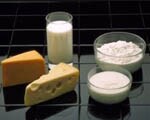Whole-fat dairy products contain a natural substance that may substantially reduce the risk of type 2 diabetes. Scientists have identified the compound, trans-palmitoleic acid, a fatty acid found in milk, cheese, yogurt, and butter.

Circulating palmitoleic acid, in the cis-form, is found naturally in the human body, but the trans-form is not produced by us and only comes from the diet. Whole milk has more trans-palmitoleic acid than 2 percent milk and 2 percent milk has more of this fatty acid than does skim milk.
Animal studies of the naturally occurring palmitoleic acid have previously shown that it can protect against insulin resistance and diabetes. Health experts generally advise reducing full-fat dairy products, but research in humans has suggested that greater dairy consumption of diets rich in dairy foods is associated with a lower diabetes risk and related metabolic abnormalities. However, the reason for this association hasn't been clear.
To assess whether this overlooked and relatively rare fatty acid might contribute to dairy's apparent protective effect, the researchers reviewed data from over 3,736 adults enrolled in a Cardiovascular Health Study who were followed for 20 years. All of the participants were over 65 years and their blood samples were analysed for the presence of trans-palmitoleic acid, as well as risk factors such as blood cholesterol, triglycerides, C-reactive protein and glucose levels. The participants provided information on their usual diets and were followed for development of type 2 diabetes.
It was found that the people with higher levels of trans-palmitoleic acid at baseline had slightly less fat on their bodies. They also had higher "good" cholesterol levels and lower overall cholesterol levels and lower levels of C-reactive protein, a marker of inflammation. They also showed evidence of lower levels of insulin and insulin resistance.
Most significantly, however, those with higher trans-palmitoleic acid levels had lower risks of developing type 2 diabetes. Those with the highest levels of trans-palmitoleic acid reduced their odds of type 2 diabetes by nearly two-thirds.
In contrast to the types of industrially produced trans fats found in partially hydrogenated vegetable oils, which have been linked to higher risk of heart disease, trans-palmitoleic acid is almost exclusively found in naturally-occurring dairy and meat trans fats, which in prior studies have not been linked to higher heart disease risk. The researchers speculate whether this naturally occurring trans fatty acid in dairy fats may partly mimic the normal biologic role of cis-palmitoleic acid that is produced in the body. The researchers said that it's difficult to know exactly how many servings of dairy it would take to get to the highest levels of trans-palmitoleic acid, but said it was likely three to five servings a day, depending on the type of dairy consumed.
The study confirms that something about dairy is linked very strongly to a lower risk of diabetes, but no single study should be enough to change guidelines and it's too soon to make any dietary recommendations based on the results of just this finding.
DoctorNDTV is the one stop site for all your health needs providing the most credible health information, health news and tips with expert advice on healthy living, diet plans, informative videos etc. You can get the most relevant and accurate info you need about health problems like diabetes, cancer, pregnancy, HIV and AIDS, weight loss and many other lifestyle diseases. We have a panel of over 350 experts who help us develop content by giving their valuable inputs and bringing to us the latest in the world of healthcare.












